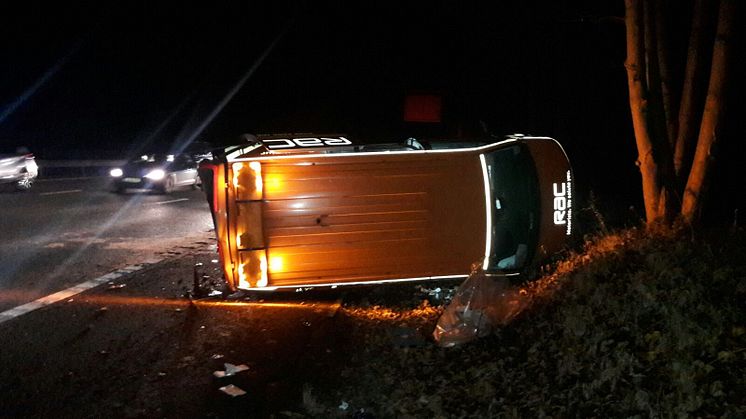
Press release -
Call for drivers to ‘slow down, make space and move on’ when passing breakdowns
The RAC has taken the unusual step of releasing photographs of an horrific accident which occurred last Thursday evening (23/11/17) on the westbound hard shoulder of the M4 near Swindon to draw attention to the significant risk of breaking-down on the motorway.
There have been two tragic motorway fatalities this year of roadside operators – one on the M25 and one on the M69. This latest serious accident on the M4 starkly illustrates the dangers that roadside technicians face when attending motorway breakdowns.
In response the RAC is launching a campaign to encourage drivers to reduce their speed and increase the gap between their car and any vehicle and people on the hard shoulder, or indeed, in an emergency refuge area on a smart motorway.
RAC health and safety consultant Steve Robinson said: “The RAC is calling on drivers to ‘slow down, make space and move on’ when passing motorway breakdowns leaving plenty of space between their car and any vehicles and people on the hard shoulder.
“With traffic volumes rising and several recent serious accidents involving roadside assistance patrols and breakdown contractors we need motorists to consider a new approach to how they drive past stricken vehicles, drivers and passengers, and those working in vulnerable locations.”
“By following this simple message we can significantly reduce the risk of a collision and, importantly, the fear factor for those standing or working at the side of the motorway.”
- Slow down – take care when passing any vehicle and people on the side of the motorway, reduce your speed and reduce the risk
- Make space – widen the gap between your car and the broken-down vehicle and roadside workers. Use all of your lane by moving over to the right, only change lane if it is safe to do so
- Move on – get safely past the breakdown situation and avoid ‘rubber-necking’, or the temptation stare at someone’s else’s misfortune – it’s a unnecessary distraction from your focus on the road ahead
In the latest accident roadside technician Andrew Barrett, an RAC patrol for 14 years, was assisting a motorist whose car had suffered a puncture and was stopped on the hard shoulder near junction 15. He had positioned his patrol van, correctly as trained, with lights and beacons flashing a distance from the member’s vehicle and asked them to stand well back on the grass verge. Andrew was changing the wheel on the off-side of the vehicle when another car travelling at speed collided with his patrol vehicle.
The collision was of such force that it rolled the three-tonne patrol vehicle, pushing it along the hard shoulder. The RAC member is believed to have struck his head and was knocked unconscious as he moved out of the way. Surprisingly, the driver of the car which struck the patrol van, although injured, was able to climb out of his vehicle.
Andrew went to assist the member on the hard shoulder and alerted the police and ambulance service. The police, fire brigade and ambulance service arrived at the scene swiftly and the westbound M4 was closed for approximately an hour and a half while and the crews attended and the damaged vehicles were removed, the carriageway cleared and re-opened.
Andrew said: “It was horrific. One minute I was changing the customer’s front wheel the next I heard an almighty crunch and looked up to see my van rolling over towards us and the car spinning into the live lane. It was not an experience I want to repeat and it certainly shows you can never be complacent when attending a motorway breakdown.
“I want to thank all those who assisted from the off-duty nurse who was first on the scene and swiftly joined by two off-duty paramedics and to the fire brigade, police, highways and the ambulance crew who were all brilliant.”
Steve Robinson said: “This was a major accident. It is a wonder that nobody was killed. This incident serves to show how dangerous it can be for anyone who has to stop on the hard shoulder of a busy motorway. We have released these shocking photographs of the RAC patrol van as they clearly demonstrate the need for a new way of thinking when drivers encounter stricken motorists and breakdown operators at the roadside.
“Our patrols attend hundreds of broken-down vehicles every week on motorways, dual carriageways and high speed roads where they may be working just a few feet from cars and lorries speeding past at 70mph-plus. They are all trained in health and safety and risk management to take control of a breakdown scene and prioritise the safety of the driver and their passengers.”
It is important that motorists familiarise themselves with what to do if they have a motorway breakdown and to ensure they make their vehicle and their passengers as safe as possible by using their lights and hazard lights, wearing a high-visibility vest and standing in a place of safety. Check our advice for what to do in the event of a motorway breakdown on the rac.co.uk website.
Steve Robinson added: “Until you find yourself stood or working on the hard shoulder it’s impossible to comprehend just how frightening it can be and what it feels like when cars and lorries are passing you at high speeds. Anyone who has experienced it will understand how vulnerable it can feel and why it makes sense to slow down and move over when passing anyone –whether broken down or working at the side of a live lane.”
Topics
Categories
About the RAC
First formed in 1897 the RAC has been looking after the needs of its members and championing the interests of motorists for 120 years.
Today it has more than eight million members and is one of the UK’s most progressive motoring organisations, providing services for both private and business motorists. Whether it's roadside assistance, insurance, buying a used car, vehicle inspections and checks, legal services or up-to-the-minute traffic and travel information – the RAC offers a solution for all motoring needs. The RAC is committed to making motoring easier, safer, more affordable and more enjoyable for drivers and road users.
The RAC is the motorist’s champion and campaigns to support the interests of its members and UK motorists at a national level. This includes voicing concerns about the increasing cost of motoring, particularly the price of fuel and the high level of tax levied on it, advancing levels of road safety, and supporting the needs of all drivers, from young to old.
The RAC’s annual Report on Motoring – first published in 1989 – provides a clear insight into the concerns and issues facing today’s motorists.
For the very latest news on UK fuel prices, check RAC Fuel Watch or follow #racfuelwatch on Twitter. RAC Fuel Watch is a comprehensive guide to the latest UK unleaded petrol and diesel prices – both at the wholesale level and at the pump. RAC Fuel Watch analyses how prices changed through the previous month and compares the most recent prices with those from three, six and 12 months before.
Key facts:
- RAC patrols fix four out of five vehicles at the roadside and on average within 30 minutes
- RAC vans carry more than 500 parts and tools to get members’ vehicles going again
- 92% of members would recommend RAC Rescue to their friends and family





